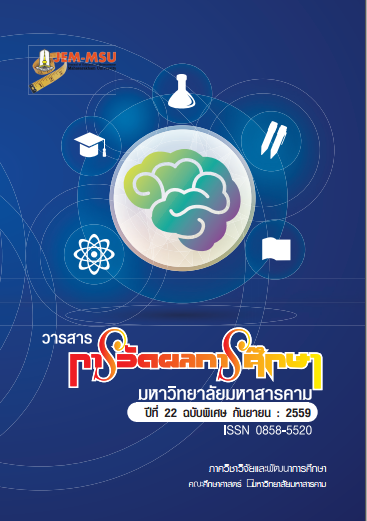การเปรียบเทียบการคิดวิเคราะห์ ความสามารถในการแก้โจทย์ปัญหาทางคณิตศาสตร์ และผลสัมฤทธิ์ทางการเรียนคณิตศาสตร์ เรื่อง การวิเคราะห์ข้อมูลเบื้องต้น กลุ่มสาระการเรียนรู้คณิตศาสตร์ ของนักเรียนชั้นมัธยมศึกษาปีที่ 5 ที่มีการจัดกิจกรรมการเรียนรู้แบบร่วมมือร่วมกัน (LT) กับการเรียนรู้แบบปกต
Main Article Content
บทคัดย่อ
-
Article Details
ประเภทบทความ
บทความวิจัย
เนื้อหาและข้อมูลในบทความที่ลงตีพิมพ์ในวารสารการวัดผลการศึกษา มหาวิทยาลัยมหาสารคาม ถือเป็นข้อคิดเห็นและความรับผิดชอบของผู้เขียนบทความโดยตรง ซึ่งกองบรรณาธิการวารสาร ไม่จำเป็นต้องเห็นด้วย หรือร่วมรับผิดชอบใดๆ
บทความ ข้อมูล เนื้อหา รูปภาพ ฯลฯ ที่ได้รับการตีพิมพ์ในวารสารการวัดผลการศึกษา มหาวิทยาลัยมหาสารคาม ถือเป็นลิขสิทธิ์ของวารสารการวัดผลการศึกษา มหาวิทยาลัยมหาสารคาม หากบุคคลหรือหน่วยงานใดต้องการนำทั้งหมดหรือส่วนใดส่วนหนึ่งไปเผยแพร่ต่อหรือกระทำการใดๆ จะต้องได้รับอนุญาตเป็นลายลักษณ์อักษรจากวารสารการวัดผลการศึกษา มหาวิทยาลัยมหาสารคาม ก่อนเท่านั้น


